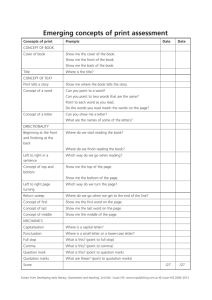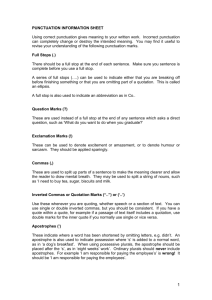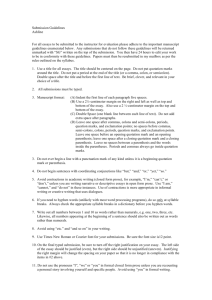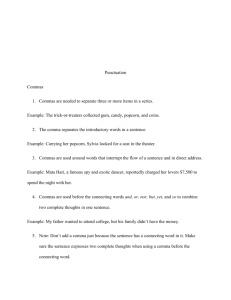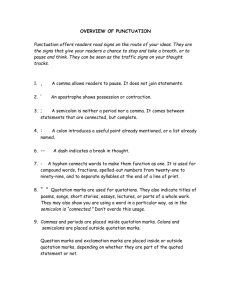Notes
advertisement
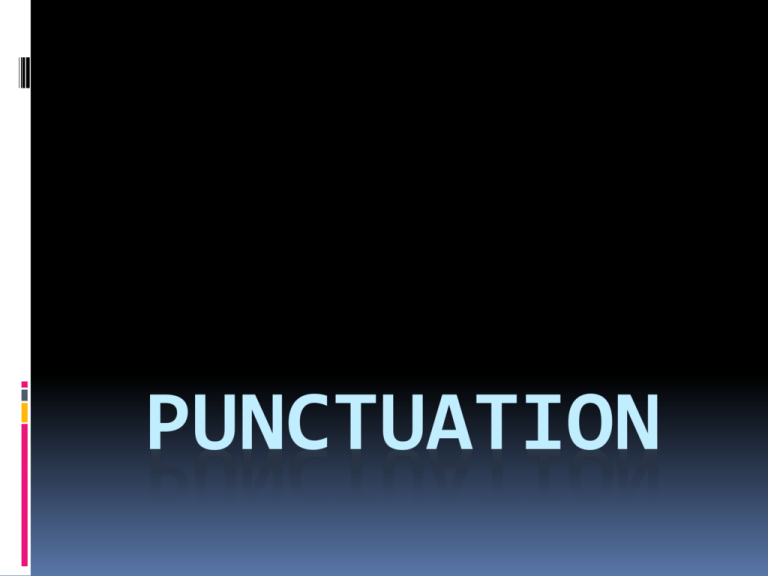
PUNCTUATION End Marks End marks signal the end of conclusion of a sentence, word or phrase. They are: period (.), question mark (?), and exclamation mark (!) Using Periods A period indicates the end of a sentence or an abbreviation Use a period to end a declarative sentence – a statement of fact or opinion Declarative Sentence: This is a beautiful park. Use a period to end most imperative sentences – sentences that give directions or commands Imperative Sentence: Finish reading the chapter. Use a period to end a sentence that contains an indirect question – restates a question in a declarative sentence; doesn’t give the speaker’s exact words. Indirect Question: Mae asked me if I could stay. End Marks continued… Use a period after most abbreviations and initials. Abbreviations: Gov. Mrs. Rd. in. Jr. Initials: E. B. White Robin F. Brancato EXAMPLE: Be sure to include Jack Jenkins Jr. Do not use periods with acronyms – words formed with the first or first few letters in a series of words EXAMPLES: USA United States of America UN United Nations End Marks continued… Using Question Marks A question mark follows a word, phrase, or sentence that asks a question. Use a question mark after an interrogative sentence – one that asks a direct question Interrogative sentences: Do snakes hatch from eggs? Would you like to come over? Use a question mark after a word or phrase that asks a question. EXAMPLES: Many small birds build false nests. Why? Let’s meet for lunch. Where? End Marks continued… Using Exclamation Marks Use an exclamation mark to end word, phrase or sentence that shows strong emotion. EXAMPLES: Look at that huge vulture! Watch out! Use an exclamation mark after an imperative sentence that gives a forceful or urgent command. Imperative sentence – Don’t spill the water! Let’s go! Mild imperatives – Please sit down. Go to the store for me tomorrow. Use an exclamation mark after an interjection that expresses strong emotion. Interjections – Wow! That was a great throw. Oh! Look what I found. Commas Commas signal a brief pause; they may be used to separate elements in a sentence or to set off a part of a sentence. Include a comma in your writing when you want your reader to group information in your sentence. Using Commas in Compound Sentences A compound sentence consists of 2 or more main or independent clauses joined by a coordinating conjunction such as and, but, for, or, so or yet. Use a comma before the conjunction in a compound sentence Compound Sentence: Chimpanzees are full grown at age five, but their mothers still take care of them. Commas continued… Use a comma before the conjunction only when there are complete sentences on both sides of the conjunction; if the conjunction joins single words, phrases, or subordinate clauses, don’t use a comma. Single Words: Heat and sand are common desert features. Phrases: Teri likes both green apples and red apples. Subordinate clauses: They have decided that you should study more and that they will check on you. In some compound sentences, the main clauses are very brief, and the meaning is clear. When this happens, the comma before the conjunction may be omitted. EXAMPLE: Jon listened carefully but he heard nothing. Commas continued… Avoiding Comma Splices A comma splice is when two or more sentences have been joined with only a comma between them. Avoid by making sure all ideas are properly linked INCORRECT: The snow clumped on the trees, many branches snapped under its weight. CORRECT: The snow clumped on the trees. Many branches snapped under its weight. Commas continued… Using Commas in a Series Use commas to separate three or more words, phrases, or clauses in a series. A comma follows each of the items except for the last one in a series; the conjunction and or or is added after the last comma. SERIES OF WORDS: The desert animals included camels, toads, gerbils, and insects. SERIES OF PHRASES: The treasure map direct them over the dunes, into the oasis, and past the palm tree. There are 2 exceptions to this rule: (1) if each item except the last one in a series is followed by a conjunction – don’t use a comma; (2) don’t use a comma to separate groups of words that are considered to be one item. EXAMPLES: I visited castles and museums and forts. Every table in the diner was set with a knife and fork, a cup and saucer, and salt and pepper. Commas continued… Using Commas Between Adjectives Sometimes two or more adjectives are placed before the noun they describe; use commas to separate adjectives of equal rank. Two ways to tell when they are of equal rank: (1) if the word and can be placed between the adjectives without changing the meaning, and (2) if the order of adjectives can be changed. EXAMPLE: A smooth, round stone was cupped in her hand. Don’t use commas to separate adjectives that must appear in a certain order. INCORRECT: It will take three and brief hours to reach the park. INCORRECT: It will take brief three hours to reach the park. CORRECT: It will take three brief hours to reach the park. Don’t use a comma to separate the last adjective in a series from the noun it modifies. INCORRECT: A large, gentle, camel stood by the road. CORRECT: A large, gentle camel stood by the road. Commas continued… Using Commas After Introductory Words, Phrases, and Clauses Use a comma after most introductory words, phrases or dependent clauses. KINDS OF INTRODUCTORY MATERIAL Introductory Word Hey, give me your camera quickly before the kangaroo moves. Pete, please bring me my shoes and socks. Well, I certainly didn’t expect that to happen. Tomi, where are you? Introductory Phrase To conserve water, some plants drop off their leaves. With Mark gone, Jake didn’t know how he would get home. In the center of the city, you will see many skyscrapers. To visit Japan, you need a passport. Introductory Adverbial Clause Although the alarm had gone off, the police arrived too late. When the mice got into the garage, they ate the birdseed. When the home team entered the stadium, the crowd loudly cheered every player. *When a prepositional phrase of only 2 words begins a sentence, a comma isn’t absolutely necessary. EXAMPLES: At night we heard the crickets. In July we go to the lake. For hours she patiently waited for the plane. Commas continued… Using Commas With Parenthetical Expressions A parenthetical expression is a word or phrase not essential to the meaning of the sentence; they add extra info to the basic sentence. Use commas to set off parenthetical expressions from the rest of the sentence One in the middle of the sentence needs 2 commas; one at the end only needs 1 KINDS OF PARENTHETICAL EXPRESSIONS Names of People Being Addressed Listen carefully, Lucinda, while I explain. Don’t be late, Randy. Certain Adverbs The sand dune, therefore, is several meters higher. Your answer is incorrect, however. Common Expressions They believe in her ability, of course. She was not given enough credit, in my opinion. Contrasting Expressions The decision should be mine, not yours. These flowers, not those, are ready to be picked up. Commas continued… Using Commas With Nonessential Expressions To determine when a phrase or clause should be set off by commas, decide whether the phrase is essential or nonessential to the meaning of the sentence. Nonessential expressions can be left out without changing the meaning of the sentence. Use commas to offset nonessential expressions from the main clause; do not set off essential material with commas. Appositives are often set off by commas, but only when their meaning isn’t essential to the sentence. ESSENTIAL: The 1943 movie Sahara takes place in North Africa. NONESSENTIAL: Sahara, a 1943 movie, takes place in North Africa. Participial Phrases are set off with commas when their meaning is nonessential. ESSENTIAL: The man waiting in the van is our guide. NONESSENTIAL: Pat, waiting in the van, asked us to hurry. Adjectival phrases are set off with commas only if they are nonessential. ESSENTIAL: We need someone who can lead us to the playing field. NONESSENTIAL: We cheered enthusiastically for Darius, who could lead us to the playing field. Commas continued… Using Commas with Dates and Geographical Names Dates have several parts and commas prevent them from being unclear. When a date is made up of three parts, use a comma after each item, except in the care of a month followed by a day EXAMPLES: On July 12, 1979, Aunt Mei arrived in this country with just a few possessions. Tuesday, March 18, was carefully circled on his calendar. When a date only contains a month and year, no comma is needed. EXAMPLES: I will graduate June 2010. Most of the storms we experienced in march 2011 dropped a lot of snow. Commas continued… When a geographical name is made up of a city and state, use a comma after each item. EXAMPLES: They lived in Marietta, Georgia, for several years and then moved to Sarasota, Florida. Mari went to Santa Fe, New Mexico, to visit the many art galleries in the area. Commas continued… Using Commas in Numbers With large numbers of more than three digits, count from the right and add a comma to the left of every third digit to separate it from every fourth digit. EXAMPLES: 2, 532 bricks 749,000 birds a population of 1, 806, 421 Use commas with three or more numbers written in a series. EXAMPLES: Read pages 123, 124, and 125 carefully The groups originally had 101, 103, and 107 members. Don’t use a comma with ZIP Codes, telephone numbers, page numbers, years, serial numbers, or house numbers. ZIP CODE: 14878 TELEPHONE NUMBER: (607) 555-1328 PAGE NUMBER: on page 1817 YEAR: the year 2010 SERIAL NUMBER: 402 36 4113 HOUSE NUMBER: 1801 Houston Street Commas continued… Using Commas With Addresses and in Letters Use a comma after each item in an address made up or two or more parts. EXAMPLE 1: She is writing to Helen Till, 1402 Cray Street, Carey, Ohio 43316. EXAMPLE 2: Maxwell Hunnicutt 54 Monmouth Avenue Dallas, Texas 75243 Use a comma after the salutation in a personal letter and after the closing in all letters. SALUTATION: Dear Shawn, CLOSING: Sincerely, Commas continued… Using Commas With Direct Quotations Use commas to set off a direct quotation from the rest of the sentence. EXAMPLES: Bret said, “Hold the door open.” “I can’t,” Lorna replied, “because my arms are full.” Semicolons and Colons The semicolon (;) joins related independent clauses and signals a long pause than a comma. The colon (:) is used to introduce lists of items and in other special situations. Using Semicolons to Join Independent Clauses Use a semicolon to join related independent clauses that are not joined by the conjunctions and, or, nor, for, but, so, or yet. INDEPENDENT CLAUSES: The fire began with a tossed match. Jamestown was burned in 1676. DEPENDENT CLAUSES: The fire began with a tossed match; all of Jamestown began to burn. Semicolons and Colons continued… When a sentence contains three or more related independent clauses, they mat still be separated with semicolons. EXAMPLES: The birds vanished; the sky grew dark; the little pond was still. Marie won the backstroke events; Tamara won the freestyle events; Jana won the butterfly. Semicolons and Colons continued… Using Semicolons to Join Clauses separated by Conjunctive Adverbs or Transitional Expressions Use a semicolon to join independent clauses separated by either a conjunctive adverb or a transitional expression. CONJUNCTIVE ADVERBS: also, besides, consequently, first, furthermore, however, indeed, instead, moreover, nevertheless, otherwise, second, then, therefore, thus TRANSIONAL EXPRESSIONS: as a result, at this time, for instance, in fact, on the other hand, that is EXAMPLE: We were impressed with Martin’s knowledge of history; indeed, he was very well informed about colonization. Semicolons and Colons continued… Using Semicolons to Avoid Confusion Consider the use of semicolons to avoid confusion when items in a series already contain commas. Place a semicolon after all but the last complete item in a series. EXAMPLES: The fans, cheering; the band, playing loudly; and the cheerleaders, yelling, helped inspire the team to play well. Three important dates in this year are April 30, 2011; May 10, 2011; and June 7, 2011. Semicolons and Colons continued… Using Colons Use a colon (:) after an independent clause to introduce a list of items. The clause that comes before the colon often includes the words the following, as follows, these, or those. EXAMPLE: Some orchids only grow in the following countries: Costa Rica, Peru, and Brazil. In most cases, don’t use a colon after a verb, and never use a colon after a preposition. INCORRECT: Veronica always orders: soup, salad, and dessert. CORRECT: Veronica always orders soup, salad, and dessert. Semicolons and Colons continued… Use a colon to introduce a long or formal quotation. EXAMPLE: The sign clearly states the law: “Dogs within the park boundaries must be leashed at all times.” SOME ADDITIONAL USES OF THE COLON To Separate Hours and Minutes 3:15 p.m. 9:45 a.m. After the Salutation in a Business Letter Gentlemen: Dear Miss Robinson: On Warnings and Labels Warning: The ice is thin. Note: Shake before using. Caution: Children playing. Quotation Marks, Underlining, and Italics Using Quotation Marks With Quotations Quotation marks (“ “) set off direct quotations, dialogue, and certain types of titles. Other titles may be underlined or set in italics. Quotation marks identify spoken or written words. A direct quotation represents a person’s exact speech or thoughts. Direct quotations should be enclosed in quotation marks. EXAMPLES: Kate said, “Williamsburg had the first theater.” “Where is the key?” asked Caroline. An indirect quotation reports the general meaning of what a person said or thought. EXAMPLES: Margo said that she would take the dog out. Don wondered why the president hadn’t called him with the results. Quotation Marks, Underlining, and Italics continued… Direct Quotations With Introductory Expressions Commas are used to indicate where introductory expressions end. When an introductory expression precedes a direct quotation, place a comma after it, and write the quotation as a full sentence. EXAMPLES: The guide explained, “All historical buildings should be treated with respect.” The coach warned, “If you don’t show up for ever practice, you won’t play in the game.” If an introductory expression is very long, set it off with a colon instead of a comma. EXAMPLE: At the end of the practice, Sarah spoke of her dreams: “I hope to be able to run the final leg in the relay by my senior year.” Quotation Marks, Underlining, and Italics continued… Direct Quotations With Concluding Expressions Direct quotations may sometimes end with concluding expressions. When this follows a direct quotation, write the quotation as a full sentence ending with a comma, question mark, or exclamation mark inside the quotation marks. Then, write the concluding expression. Be sure to use end punctuation. Concluding expressions don’t begin with capital letters because they aren’t complete sentences. EXAMPLE: “Could you show us one of the houses?” interrupted Barney. Quotation Marks, Underlining, and Italics continued… Direct Quotations With Interrupting Expressions You may use an interrupting expression as a direct quotation, also called a divided quotation. They help writers clarify who’s speaking and can break up a long quotation. When the direct quotation of a sentence is interrupted, end the first part of the direct quote with a comma and quotation mark. Place a comma after the interrupting expression and use a new set of quotation marks to enclose the rest of the quotation. Don’t capitalize the first word of the second part of the sentence. EXAMPLES: “What would we have done,” asked Corrina, “if we had lived in the path of the tornado?” “If you get a new bicycle,” my mother warned, “you’ll have to remember to lock it up.” Quotation Marks, Underlining, and Italics continued… When two sentences in a direct quotation are separated by an interrupting expression, end the first quoted sentence with a comma, question mark, or exclamation mark and a quotation mark. Place a period after the interrupter, and then write the second quoted sentence as a full quotation. EXAMPLES: “Did you see those rooms?” asked Mark. “Can you imagine having such a large house?” “I know I had my keys when I left,” Jane said. “They are probably in my pocket.” Quotation Marks, Underlining, and Italics continued… Using Quotation Marks With Other Punctuation Marks Always place a comma or a period inside the final quotation mark. EXAMPLES: “This area needs work,” Mrs. Finch said. She added, “It looks like you’re living in a junkyard, not a room.” Place a question mark or exclamation mark inside the final quotation mark if the end mark is part of the quotation. Don’t use additional end marks outside the quotation marks. EXAMPLES: Joe asked, “Didn’t I already clean that room?” Salvatore, his brother, protested loudly, “I helped rebuild three buildings last summer!” Place a question mark or exclamation mark outside the final quotation mark if the end mark is part of the entire sentence, not the qu0tation. EXAMPLES: Did he say, “You have wasted your entire day” ? I can’t believe he said, “I like taking tests” ! Quotation Marks, Underlining, and Italics continued… Using Single Quotation Marks for Quotations Within Quotations Use single quotation marks ( ‘ ’ ) to separate a quote that appears inside of another quotation. EXAMPLES: “Did you mean to say, ‘That’s my cat,’ or ‘That’s my hat’?” Lori asked. Steve said, “I thought I heard myself yell, ‘Fire!’ That’s why I ran out the door.” Punctuating Explanatory Material Within Quotes Use brackets to enclose an explanation located within a quotation to show that the explanation is not part of the original quotation. EXAMPLES: The mayor said, “This bridge is more than a link between two communities [Oceanville and Riverton].” “We [the students of Center High School] wish to express our support of the student council.” Quotation Marks, Underlining, and Italics continued… A conversation between two people is called dialogue. When writing dialogue, indent to begin a new paragraph with each change of speaker. Add quotation marks around a speakers words. When a new speaker is quoted, be sure to indicate the change to your reader by adding info indentifying the new speaker. EXAMPLE: “Will you be going with us on the family trip again this summer?” Noreen asked her cousin. Gwen hesitated before answering. “I’m afraid so. My parents think I enjoy the experience of traveling with our whole family.” “You fooled me, too,” Noreen replied. “Maybe the trip will be better this year. I think we’re going to placed that have large parks. If we’re lucky, we might even be able to go on a few rides.” “Well, at least it can’t be any worse,” sighed Gwen. “On the last trip, we waited in line for one hour at three different historic homes in one day!” “I remember those lines,” said Noreen. “Didn’t you get sunburned while we were waiting?” Quotation Marks, Underlining, and Italics continued… Using Quotation Marks in Titles Use quotation marks to enclose the titles of short written works and around the title of a work that is mention as part of a collection. WRITTEN WORKS THAT USE QUOTATION MARKS Title of a Short Story “The Gift of the Magi” Chapter From a Book ‘The Test Is in the Tasting” from No-Work Garden Book Title of a Short Poem “Lucy” Title of an Article “How to Build a Birdhouse” Title Mentioned as Part of a Collection “Uncle Vanya” in Eight Great Comedies Quotation Marks, Underlining, and Italics continued… Use quotation marks around the titles of episodes in television or radio series, songs, and parts of a long musical composition. ARTISTIC WORKS THAT USE QUOTATION MARKS Title of an Episode “The Nile” from Cousteau Odyssey Title of a Song ‘The Best Things in Life Are Free” Title of a Part of a Long Musical Work “The Storm” from the William Tell Overture Using Underlining and Italics in Titles Underlining or italics help make titles or other special words stand out in your writing. Underlining is used only in handwritten or type written material. Italic print is used instead of underlining in printed material. UNDERLINING: The Hobbit ITALICS: The Hobbit Quotation Marks, Underlining, and Italics continued… Underline or italicize the titles of long written works and publications that are published as a single work. WRITTEN WORKS THAT ARE UNDERLINED OR ITALICIZED Title of a Book or Play War and Peace, Guys and Dolls Title of a Long Poem Paradise Lost Title of a Magazine or Newspaper People, The New York Times Underline or italicize the titles of movies, television and radio series, long works of music, and art. ARTISTIC WORKS THAT ARE UNDERLINED OR ITALICIZED Title of a Movie Notting Hill Title of a Television Series Friends Title of a Long Work of Music Surprises Symphony Title of a Music Album TJ’s Greatest Hits Title of a Painting Mona Lisa Title of a Sculpture The Thinker Quotation Marks, Underlining, and Italics continued… Underline or italicize the names of air, sea, or spacecraft. EXAMPLES: Gemini 5 the Titanic Underline or italicize words and letters used as names for themselves and foreign words. EXAMPLES: How do you spell alligator? A Japanese obento is a homemade lunch. Hyphens Hyphens (-) are used to combine words and to show a connection between the syllables of words that are broken at the end of lines. Using Hyphens in Numbers Use a hyphen when you write two-word numbers from twenty-one to ninety-nine. EXAMPLES: seventy-eight thirty-five Use a hyphen when you use a fraction as an adjective but not when you use a fraction as a noun. EXAMPLES Adjective: The glass is two-thirds full. Noun: Two thirds of the members were present. Hyphens continued… Using Hyphens for Prefixes and Suffixes Use a hyphen after a prefix that is followed by a proper noun or adjective. (ante-, anti-, post-, pre-, pro-, and un-) EXAMPLES: pre-Columbian mid-August Use a hyphen in words with the prefixes all-, ex-, and selfand the suffix –elect. EXAMPLES: all-American mayor-elect Using Hyphens in Compound Words Use a hyphen to connect two or more nouns that are used as one compound word. EXAMPLES: great-grandfather treasurer secretary- Hyphens continued… Using Hyphens With Compound Modifiers Use a hyphen to connect a compound modifier that comes before a noun. Don’t use a hyphen with a compound modifier that includes a word ending in –ly or in a compound proper adjective. EXAMPLE: Cass was a big-hearted dog lover. INCORRECT: clearly-written text West-Indian music CORRECT: clearly written text West Indian music A hyphen isn’t necessary when a compound modifier follows the noun it describes. MODIFIER BEFORE NOUN: They traveled in well-equipped wagons. MODFIER AFTER NOUN: They traveled in wagons that were well equipped. If a dictionary spells a word with a hyphen the word must always be hyphenated, even when following a noun. EXAMPLE: The design is up-to-date. Hyphens continued… Using Hyphens at the Ends of Lines Hyphens are used to divide words at the ends of lines. Avoid dividing words at the end of a line whenever possible; if a word must be divided, always divide it between syllables. EXAMPLE: The soccer coach’s pep talks are usually quite uninspiring and short. A hyphen used to divide a word should never be placed at the beginning of the second line; it must be placed at the end of the first line. INCORRECT: Knock down this par -tition. CORRECT: Knock down this partition. Hyphens continued… Using Hyphens Correctly to Divide Words One syllable words cannot be divided – don’t divide them even if they seem long or sound like words with two syllables. INCORRECT: sch-ool CORRECT: school bru-ised bruised thro-ugh through Don’t divide a word so that a single letter stands alone. INCORRECT: a-mid CORRECT: amid ver-y very o-kay okay Avoid placing –ed at the beginning of a new line. INCORRECT: The school awards ceremony was halt- ed by the blackout. CORRECT: The school awards ceremony was halted by the blackout. Hyphens continued… Avoid dividing proper nouns or proper adjectives. INCORRECT: Eliza-beth CORRECT: Elizabeth Ger-man German Divide hyphenated words only immediately following the existing hyphen. INCORRECT: It was a post-sea- son soccer game. CORRECT: It was a postseason soccer game. Apostrophes The apostrophe ( ‘ ) is used to show possession or ownership. It is also used in shortened forms of words called contractions. The apostrophe marks the place where letters have been omitted. Using Apostrophes With Possessive Nouns Add an apostrophe and –s to show the possessive care of most singular nouns and plural nouns that don’t end in –s or –es. EXAMPLES: My dog’s favorite toy is a ball. The men’s trek up Mt. Everest was strenuous. Even when singular nouns end in –s, you add an apostrophe and –s to show possession. EXAMPLE: An iris’s colors are often purple and white. Apostrophes continued… In classical or ancient names that end in –s, it is common to omit the final –s to make the pronunciation easier. EXAMPLE: Odysseus’ voyages were dangerous. Add an apostrophe to show the possessive case of plural nouns ending in –s or –es. Don’t add an –s. EXAMPLE: The bears’ den is hidden in the mountains. Add an apostrophe and –s (or just an apostrophe if the word is plural ending in –s) to the last word of a compound noun to form the possessive. EXAMPLES: the Girl Scouts’ cookie sale my sister-in-law’s car Apostrophes continued… Using Apostrophes With Pronouns Use an apostrophe and –s with indefinite pronouns to show possession. EXAMPLES: another’s preference nobody else’s business Don’t use an apostrophe with possessive personal pronouns. POSSESSIVE PERSONAL PRONOUNS SINGULAR PLURAL First Person my, mine our, ours Second Person your, yours your, yours Third Person his; her, hers; it their, theirs Some of these pronouns act as adjectives EXAMPLES: The spider caught a fly in its web. Our house is for sale. Others act as subjects, objects, and subject complements. EXAMPLES: Mine is the yellow crayon. Someone broke yours. Apostrophes continued… Using Apostrophes With Contractions Contractions are used in informal speech and writing, especially in dialogue. Use an apostrophe in a contraction to show where one or more letters have been omitted. COMMON CONTRACTIONS Verb + not is not = isn’t cannot = can’t Noun or Pronoun + will I will = I’ll we will = we’ll Noun or Pronoun + be you are = you’re Andy is = Andy’s Noun or Pronoun + would she would = she’d who would = who’d Avoid using contractions in formal speech and writing. INFORMAL WRITING: What’s the solution? FORMAL WRITING: What is the solution? Apostrophes continued… Using Apostrophes to Create Plurals Use an apostrophe and –s to create the plural form of a letter, numeral, or word used as a name for itself. EXAMPLES: Mind your p’s and q’s. Remember your please’s, please.
